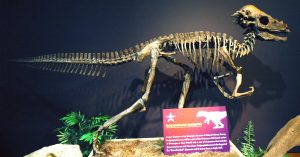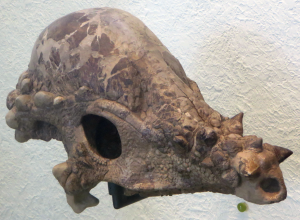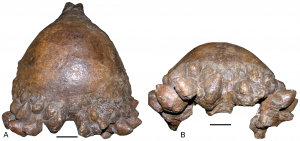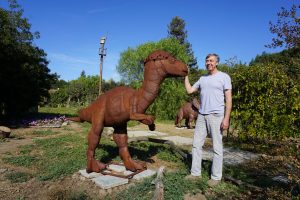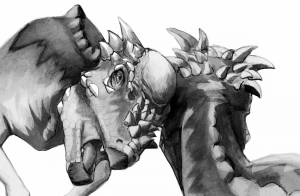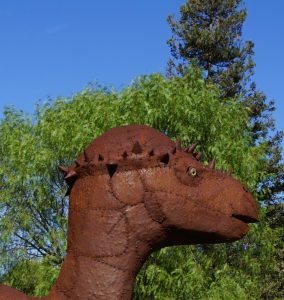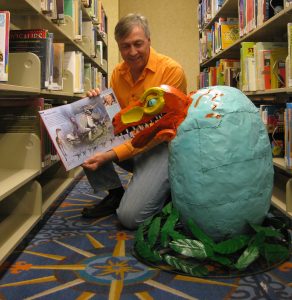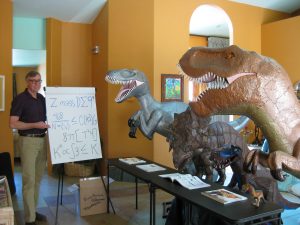The name Pachycephalosaurus comes from Greek – meaning thick headed lizard. They lived in the Cretaceous Period in Europe and North America – Montana, South Dakota & Wyoming and now one at the Park! Pamela is the Pachycephalosaurus that joined the Park in November. Pachycephalosaurus were herbivorous or omnivorous animals eating leaves, fruit, seeds and insects. They had small leaf shaped teeth. Primarily known for their extremely thick skull roof. Pachycephalosaurus is most closely related to Dracorex and Stimoloch (which had flat skulls), although current thought is these maybe juvenile forms of Pachycephalosaurus.
Special Thanks to James St. John for the Complete Skelton photo, to Janine & Jim Eden for the Skull photo & John R. Horner & Mark B. Goodman for the two angle Skull photos of Pachycephalosaurus. Pamela & I greatly appreciate them.
It was believed that the males would ram each other headlong. They would make their head, neck and body horizontally straight in order to transmit stress during ramming. New research suggests that they would more likely have glancing blows due to the round shape of their heads or have engaged in flank butting in combat. In this situation an individual may have stood roughly parallel or faced its rival directly, using intimidation displays to cow its rival. Failing this, the Pachycephalosaurus would bend its head downward and to the side, striking the rival on its flank.
Thank You Ryan Steiskal by the beautiful Head Butting Artwork for Pachycephalosaurus
No breaks, bone lesions or other injuries were found on the domes of a number of specimens, which would be expected if they were commonly used as battering rams. It is now believed these were either juveniles or female and this behavior would not be expected of them. Some theorize that the skulls were used to attract mates or to differentiate species. Perhaps it was all of the above. Studies have determined that Pachycephalosaurid domes are composed of a unique form of fibrolamellar bone which contains fibroblasts that play a critical role in wound healing and are capable of rapidly depositing bone during remodeling. This would explain the dome shape head development in the adults and the belief that Dracorex and Stimoloch are juvenile Pachycephalosaurus.
Thanks to Matt Martynik for the Growth Stages photo of Pachycephalosaurus
They lived during Late Cretaceous with Tyrannosaurus and lasted up until the very end of the reign of the Dinosaurs. They were estimated to reach 16 feet long and weigh up to 660 lbs. For more information check out the article on Wikipedia: https://en.wikipedia.org/wiki/Pachycephalosaurus
Remember January 20, 2018 at 12:00 pm Kevin the T-Rex hatchling & I will be at the
Avenue Library
606 North Ventura Ave
Ventura, CA
805 643-6393
For a Reading of Dinosaur Facts & Fun! Look Forward to Seeing You There.
“Encouraging the Appreciation of Art and Education through the Inspiration of Dinosaurs”
Paul & Prehistoric Pals
Your feedback is appreciated, Thank you!
